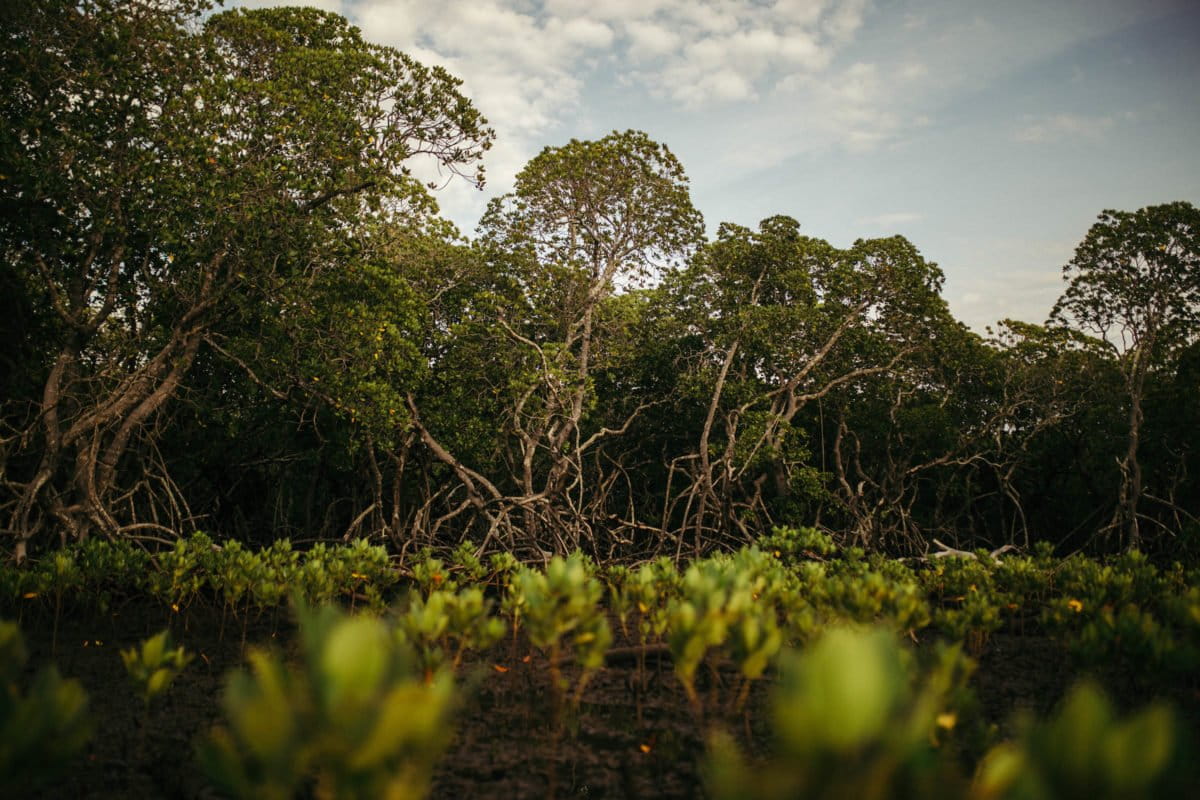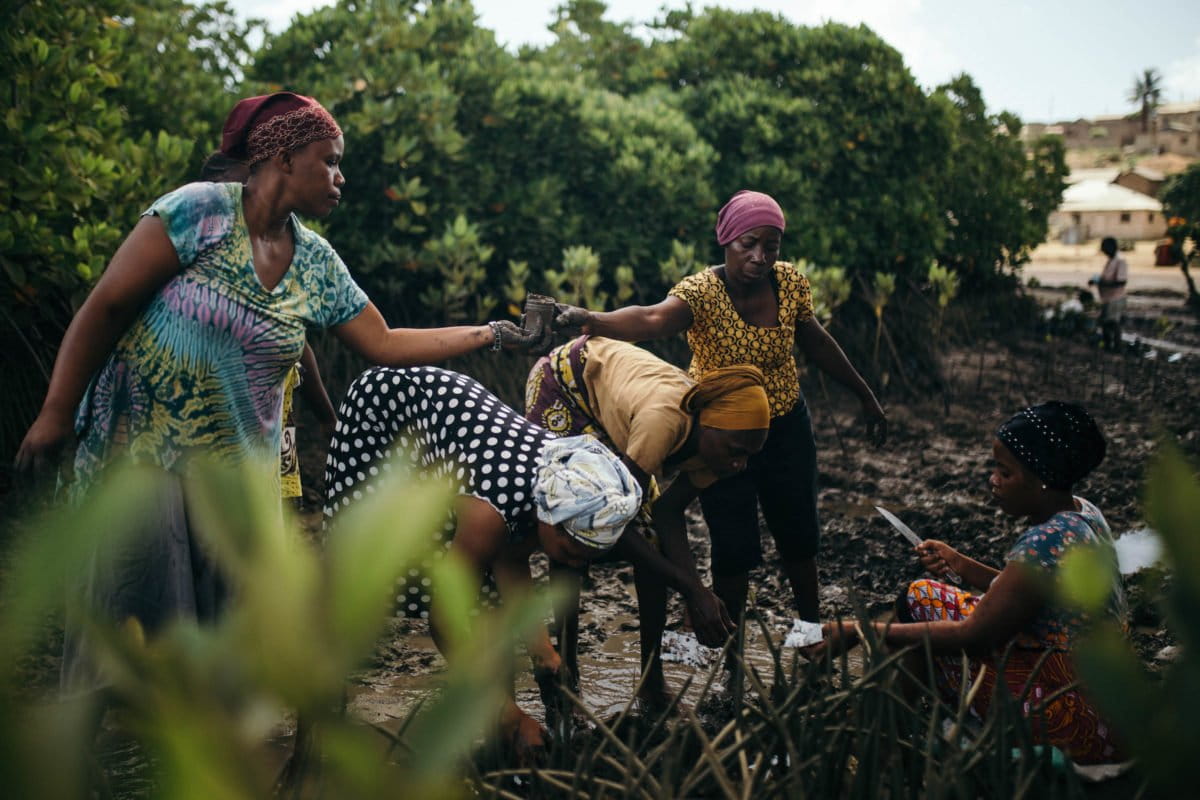Mangrove conservation takes root with local communities on Kenya’s coast
Oct 22, 2021
- Mangroves are keystones of coastal ecosystems, protecting shorelines from erosion, providing habitat for fish and other marine life, and storing large amounts of carbon.
- These coastal forests are vital to local communities who have long relied on them for things like food, fuel, and construction materials.
- Kenya has lost half of its mangrove forests in the past 50 years to a combination of factors, including overexploitation by locals with limited livelihood options.
- A variety of conservation efforts in and around the southern city of Mombasa emphasize involving communities in reducing pressure on these coastal forests.
MOMBASA, Kenya — The stands of mangrove on the shore are pocked with charred clearings. Along Tudor Creek, facing the southern Kenyan port city of Mombasa, producers of chang’aa, a local moonshine made with sorghum or millet, like to distill their brew here in the coastal forest, which offers both discretion and fuel. On the edge of one such site, the ground strewn with empty yeast packets, a group gathers with a very different purpose.
Every morning, members of the community-based organisation called the Brain Youth Group gather here to tend mangrove nurseries, plant seedlings, and harvest seeds. Mostly young women, they start early to take advantage of the cool morning temperatures, weaving across the soft, sinking mud to the restoration site of the day, their colorful kangas hitched up on their waists. Today, the main task is to transplant mangrove seedlings from nurseries into designated plots.
In the group is Nancy Cheki, a founding member of Brain who grew up in Mombasa. “I used to see the forests along the Kibarani area on the way to town but I wasn’t aware of their importance — I just knew them as trees or coastal forests.”
Later, as a university student, she learned more about mangroves and their value in combating climate change,” she says.
“Coastal people should aim at conserving and protecting these forests. First we must start with the community, since they are closest to the mangroves.”

No better biome
Mangroves are semiaquatic woody trees adapted to the conditions of the intertidal zones that range from brackish to full-strength seawater. They act as bulwarks against erosion caused by storms and wave action, sheltering fish and other marine life that coastal communities depend on for sustenance and livelihoods.
Mangrove forests are among the most carbon-rich biomes in the world: studies have found that mangrove peat accumulation compounds carbon sequestration and storage. They sequester 10 times as much carbon as other forests thanks to their extensive root networks.
The Brain Youth Group was founded in 2011 by Mbaarak Abdallah. He had plans to set up a fish farm, but after learning about the role coastal forests play in ecosystems at a workshop, he turned his attention to protecting mangroves and understanding how their health could improve fishery conditions back in Mombasa’s Junda area.
Abdallah says that at the outset, only around 20% of the mangroves the group planted survived. Planting a mix of species, choosing between transplanting seedlings or putting seeds directly in the soil, what season you plant in — it all matters. Climate change-induced alterations in sea levels and wave patterns further complicate restoration, making it easier for seedlings to get washed away or drowned. The team is now achieving survival rates as high as 80 or 90%.
“It isn’t always easy,” Abdallah says. “But we just have to keep going.”
As he washes his mud-caked boots after a foray into one of Brain’s mangrove nurseries, some fishermen approach him. Their work has been suffering this season: small fish, poor catches. He speaks with them for some time, then invites them to join the next Brain community meeting.
“You must engage with everyone in this role,” he says. “You never know where the next connection may form.”
For many coastal communities, mangroves have long been important sources of timber, fuel and medicine. Pollution, diversion and damming of rivers have changed growing conditions in estuaries, contributing to the rapid degradation of these coastal forests. Poverty and limited options for livelihoods beyond fishing have also led people to cut down mangroves more rapidly: 80% of Tudor Creek’s mangroves were lost between 1992 and 2009. Overall, Kenya has lost an estimated 50% of its mangroves in just the last 50 years.
Kenyan authorities banned the use of mangroves for construction in 1997. Although this curbed the open trading of mangrove timber, these forests remained under pressure from people struggling to make a living, cutting trees down to make chang’aa and charcoal.

Mangroves together
Marine biologist Josphat Nguu says it’s easy to blame local people for being reckless or irresponsible without accounting for the social and economic context they’re operating in. Nguu works for the Kenya Marine and Fisheries Research Institute (KMFRI) as project coordinator for a mangrove conservation project 50 kilometers (30 miles) south of Junda. Here in Gazi village, an estimated 80% of the population depend on fishing-related activities for their livelihoods.
“Our job is to make the connection between local people and their resources,” Nguu says. “After that, the ball is in their court. It is up to them to choose what to take from our interventions.”
Nguu is the project coordinator for Mikoko Pamoja (meaning “mangroves together” in Kiswahili), a conservation project financed by voluntary carbon credits. Mikoko Pamoja protects 117 hectares (289 acres) of mangroves with participation from 700 households. The project plants 4,000 seedlings a year.
But before planting even one, it installed water pipes for households in the village and bought books for local schools. The intent was to communicate that the people matter just as much as the mangroves themselves, and to promote development in tandem with establishing a sustainable source of income from protecting mangroves.
Funding for research comes from the French Embassy and Samsung, among others, but the money for mangrove restoration and community development projects comes from the sale of voluntary carbon credits, at around $24,000 a year.
Nguu says Mikoko Pamoja’s success so far rests on engaging the local community and communicating how the fate of mangroves ultimately lies with the villagers themselves.
“Awareness campaigns that put food on the table for the community trigger people to become more active in conservation. Volunteer conservation has been there for a long time, but carried out by only a few people, oftentimes outsiders. When the community sees benefits, they are propelled toward active conservation.”
Benefits reach the community through a variety of projects, including beekeeping, woodlots that supply timber for construction, and the Gazi village boardwalk, which offers a serene public space for the local community while bringing in some revenue from tourists. Particular care is taken to open roles for women as managers of many of these projects.
Mikoko Pamoja measures its success protecting mangroves by counting stumps of felled trees in plots throughout the project area. Nguu says they’ve seen a marked decline since the project started in 2013. There has also been an encouraging uptick in animal populations, crabs in particular.

Small hands, big hearts
The Brain Youth Group doesn’t have resources on this scale. It sells mangrove seedlings to other conservation organizations to make ends meet, but it’s not uncommon for members of the group that plants seedlings and takes care of the nursery to forgo the allocated $10 per day.
“The funds that we are able to secure are normally given to the members as a way to appreciate their efforts. This motivates members since they may meet their needs or even improve their living standards,” says Brain project manager Mary Gona.
Gona’s own work history points to the idealism that holds this group together. She worked on forest restoration projects as an intern for Kenya’s Ministry of Environment and Forestry, encountering the Brain Youth Group when she was assigned to mangrove reforestation in nearby Kwale county.
“I find my peace in mangrove conservation,” she says. “Once I plant a mangrove tree, I am happy because I know it is equivalent to 10 terrestrial trees in terms of carbon absorption. It gives me hope that in the coming years, instead of having adverse effects of climate change, we’ll be moving toward mitigating it.”
Founding member Cheki was drawn to the group by the example set by Abdallah: “There are so many conservators out here, but most treat it as a hustle. They avoid manual work which needs passion and of course perseverance. I have friends who I studied with and they are still shocked by how I get in the mud, but I tell them that’s where my heart is.”

Citation
Ezcurra, P., Ezcurra, E., Garcillán, P. P., Costa, M. T., & Aburto-Oropeza, O. (2016). Coastal landforms and accumulation of mangrove peat increase carbon sequestration and storage. Proceedings of the National Academy of Sciences, 113(16), 4404-4409. doi:10.1073/pnas.1519774113
Banner image: Hooded vulture. Image courtesy John Davies/EWT
FEEDBACK: Use this form to send a message to the author of this post. If you want to post a public comment, you can do that at the bottom of the page.